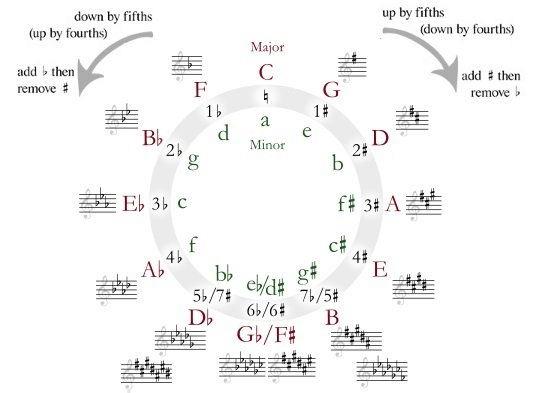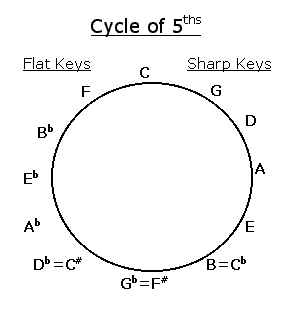
The circle of 5ths, also known as the cycle of fifths is the key to understanding harmony and modulation. The Circle of Fifths is basically a chart showing how all the keys relate to one another. There are several versions of this chart, the more common ones use only the major keys with only the chord symbols.
Who Should Learn the Circle of Fifths
Anybody, interesting in music theory, learning to play a musical instrument (intermediate level and above), and those looking to broaden their knowledge of music theory should understand the practical uses of the Circle of Fifths.
How the Circle of Fifths Helps
- Circle of Fifths is a useful chart that helps you decipher key signatures.
- Because of its clever design, it’s also a great help in writing music, composing and harmonizing melodies, building chords, and moving to different keys within a composition.
- Knowing the cycle of fifths will help you understand how to move from one chord to another i.e. it will help you get better at chord progressions, whatever be your instrument.
- Its a important tool to understand Western music. Chord progressions in western music frequently use roots that move around the circle of fifths.
- The circle is extremely useful for understanding western common practice music: pre-modern classical, folk, pop, rock and jazz.
- Keys and chords that are close to each other on the circle sounds pleasing, smooth and logical, whereas a move from one key to the other that is far away in the circle, sounds jarring and strange.

How to Use (Read) the Circle of Fifths – 12 Keys in the Cycle
Cycle of Fifths – If you look at the diagram above, you will observe that if you go clockwise, the keys get progressively sharper.
Each new key is a Fifth away from the previous key. So if you start with C (no sharps/flats), the next key is G (one sharp), then D (two sharps), and so on.
Cycle of Fourths – If you go anti-clockwise, the keys get progressively flatter. Again starting from C, the next key is F (one flat), then Bb (two flats), and so on.
This sequence is also known as the cycle of fourths since each new key is a Fourth away from the previous key.
Perfect Symmetry: Useful for Harmonizing in Different Keys
Another aspect of the circle of fifths is its perfect symmetry. If you are playing a song in any key, the most common chords that you will use for harmonizing are I, IV and V.
So, if you are playing in the C key, you will need the F and G chords, in addition to the C chord. If you look at the circle, you will see that F and G are situated one step anticlockwise and one step clockwise from C in the cycle i.e. the C chord is in the middle of the two.
This is true for each and every key. So if you have to play a song in a different key, just refer to this chart and you will know the IV and V chords for that key. They have to be adjacent to chord-I.
The Chord Wheel: The Ultimate Tool for All Musicians by Jim Fleser
One of the best music theory books for beginners. Learn to transpose, use chord progressions, compose your own music, and more. The Chord Wheel has a spin-able template that lays over the circle of fifths. It helps you easily understand the flats and sharps in each key, and gives you all the main chord substitutions for every step. The book also has some excellent chord theory instructions.
The Circle of Fifths for Guitarists
The Circle of Fifths can be applied to any musical instrument, including the guitar.
Learning how to use the Circle of Fifths will help you:
- Know the notes of any scale
- Know the chords of any key
- Recognize key signatures
- Quickly know how many sharps/flats are in any key
Final Thoughts
This was just an introduction to the cycle of fifths but I am sure you would have seen the importance of it.
Time spent on studying this will help you improve your chord progressions skills and will be of immense help as a tool for transposition and modulation.
Leave a Reply